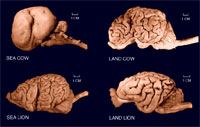Home >> Learn More >> About this site |
About this siteThis internet site is associated with the Comparative Mammalian Brain Collections site at http://brains.anatomy.msu.edu/museum/brain/
The pictures on this page can be viewed at full screen size by clicking on them. They illustrate how images from the collection can be used for comparative brain study. Images of the whole brains above are from the collection archives, as are the images of stained sections to the left. They show the relative development of two visual centers in the brain stem in mammals of differing life style: the SEA COW or MANATEE Trichechus manatus, the "LAND" COW Bos taurus, the SEA LION Zalophus californianus, and the "LAND" LION Panthera leo. Drawing at the lower left is based on an illustration from Nieuwenhuys, R., J. Voogd and C. van Huijzen, The Human Central Nervous System. Berlin: Springer-Verlag, 1978. What we are doing currently at Michigan State is a series of demonstration projects for publicizing the contents of the collections and ways in which they can be used. We have prepared databases of the contents of the collections for presentation and use on this site, as well as for downloading by users in several formats. We are also developing a series of labeled atlases of stained sections for educators, students, and researchers. |
Click here to learn how to use them for free


